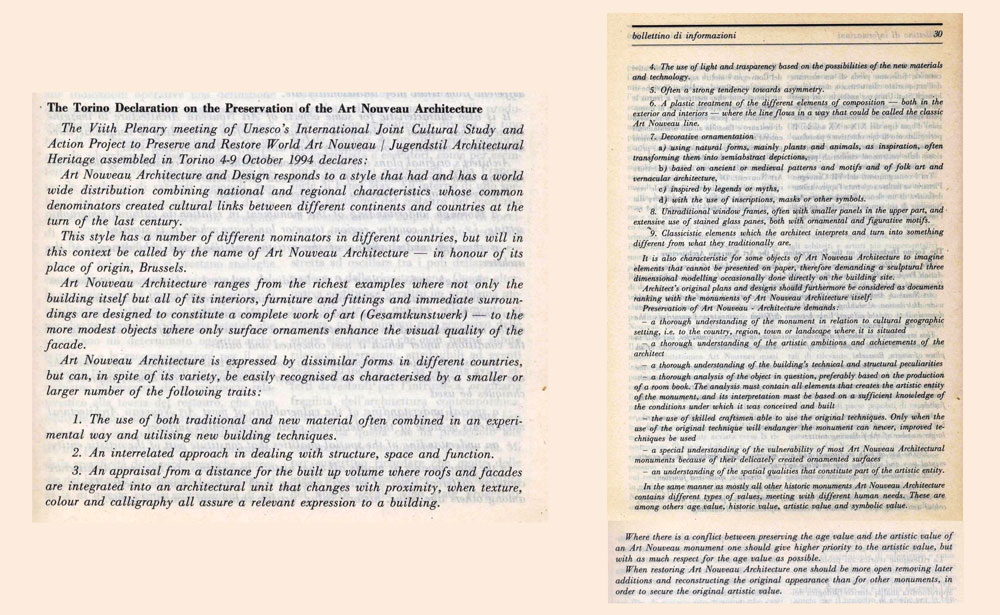The Torino Declaration on the Preservation of the Art Nouveau Architecture
The Viith Plenary meeting of Unesco’s International Joint Cultural Study and Action Project to Preserve and Restore World Art Nouveau / Jugendstil Architectural Heritage assembled in Torino 4-9 October 1994 declares:
Art Nouveau Architecture and Design responds to a style that had and has a world wide distribution combining national and regional characteristics whose common denominators created cultural links between different continents and countries at the turn of the last century.
This style has a number of different nominators in different countries, but will in this context be called by the name of Art Nouveau Architecture – in honour of its place of origin, Brussels.
Art Nouveau Architecture ranges from the richest examples where not only the building itself but all of its interiors, furniture and fittings and immediate surroundings are designed to constitute a complete work of art (Gesamtkunstwerk) – to the more modest objects where only surface ornaments enhance the visual quality of the facade.
Art Nouveau Architecture is expressed by dissimilar forms in different countries, but can, in spite of its variety, be easily recognised as characterised by a smaller or larger number of the following traits:
- The use of both traditional and new material often combined in an experimental way and utilising new building techniques
- An interrelated approach in dealing with structure, space and function
- An appraisal from a distance for the built up volume where roofs and facades are integrated into an architectural unit that changes with proximity, when texture, colour and calligraphy all assure a relevant expression to a building
- The use of light and transparency based on the possibilities of the new materials and technology
- Often a strong tendency towards asymmetry
- A plastic treatment of the different elements of composition – both in the exterior and interiors – where the line flows in a way that could be called the classic Art Nouveau line
- Decorative ornamentation
a) using natural forms, mainly plants and animals, as inspiration, often transforming them into semiabstract depictions
b) based on ancient or medieval patterns and motifs and of folk art and vernacular architecture
c) inspired by legends or myths
d) with the use of inscriptions, masks or other symbols - Untraditional window frames, often with smaller panels in the upper part, and extensive use of stained glass panes, both with ornamental and figurative motifs
- Classicistic elements which the architect interprets and turn into something different from what they traditionally are
It is also characteristic for some objects of Art Nouveau Architecture to imagine elements that cannot be presented on paper, therefore demanding a sculptural three dimensional modelling occasionally done directly on the building site. Architect’s original plans and designs should furthermore be considered as documents ranking with the monuments of Art Nouveau Architecture itself.
Preservation of Art Nouveau Architecture demands:
- a thorough understanding of the monument in relation to cultural geographic setting, i.e. to the country, region, town or landscape where it is situated
- a thorough understanding of the artistic ambitions and achievements of the architect
- a thorough understanding of the building’s technical and structural peculiarities
- a thorough analysis of the object in question, preferably based on the production of a room book. The analysis must contain all elements that creates the artistic entity of the monument, and its interpretation must be based on a sufficient knowledge of the conditions under which it was conceived and built
- the use of skilled craftsmen able to use the original techniques. Only when the use of the original technique will endanger the monument can newer, improved techniques be used
- a special understanding of the vulnerability of most Art Nouveau Architectural monuments because of their delicately created ornamented surfaces
- an understanding of the spatial qualities that constitute part of the artistic entity
In the same manner as mostly all other historic monuments Art Nouveau Architecture contains different types of values, meeting with different human needs. These are among others age value, historic value, artistic value and symbolic value.
Where there is a conflict between preserving the age value and the artistic value of an Art Nouveau monument one should give higher priority to the artistic value, but with as much respect for the age value as possible.
When restoring Art Nouveau Architecture one should be more open removing later additions and reconstructing the original appearance than for other monuments, in order to secure the original artistic value.
